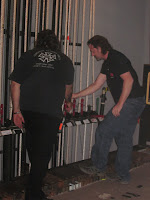
So this is the only photo I could get of the two group projects I helped light... and it's not even technically something that I lit. This is just an example of how I helped them use natural light effectively (avoid backlighting by positioning the camera and use the natural diffusion of a cloudy day).
For both shoots I forgot to check out an actual lighting kit so I had to get creative. The first shoot, Stephanie Reeves' group, was a narrative short and I mainly helped them by repositioning the lights that they already had in the room. The scenes I helped them with are the shot above and walking through the halls of the house immediately after the shot above.
The second shoot, Robert Lipe's group, was a documentary and I helped them light an interview outside an apartment in Stadium Suites. For this shoot, I decided I had better bring something so I bought two work lights and brought a lava lamp without the lava part.
The halogen work lights had a very warm color temperature that ended up working pretty nicely to contrast with the cool light of a early winter afternoon. I used the strongest work light as a key light and the lava lamp as a fill light.
Here's the link to the work lights I used.
So yeah. I had to think outside the box for both shoots. It would have been nice to get to try out an actual light kit, but I feel like I learned some useful techniques if I ever need to get better lighting out of a situation when I don't have access to good quality equipment.















 So this is the only photo I could get of the two group projects I helped light... and it's not even technically something that I lit. This is just an example of how I helped them use natural light effectively (avoid backlighting by positioning the camera and use the natural diffusion of a cloudy day).
So this is the only photo I could get of the two group projects I helped light... and it's not even technically something that I lit. This is just an example of how I helped them use natural light effectively (avoid backlighting by positioning the camera and use the natural diffusion of a cloudy day).